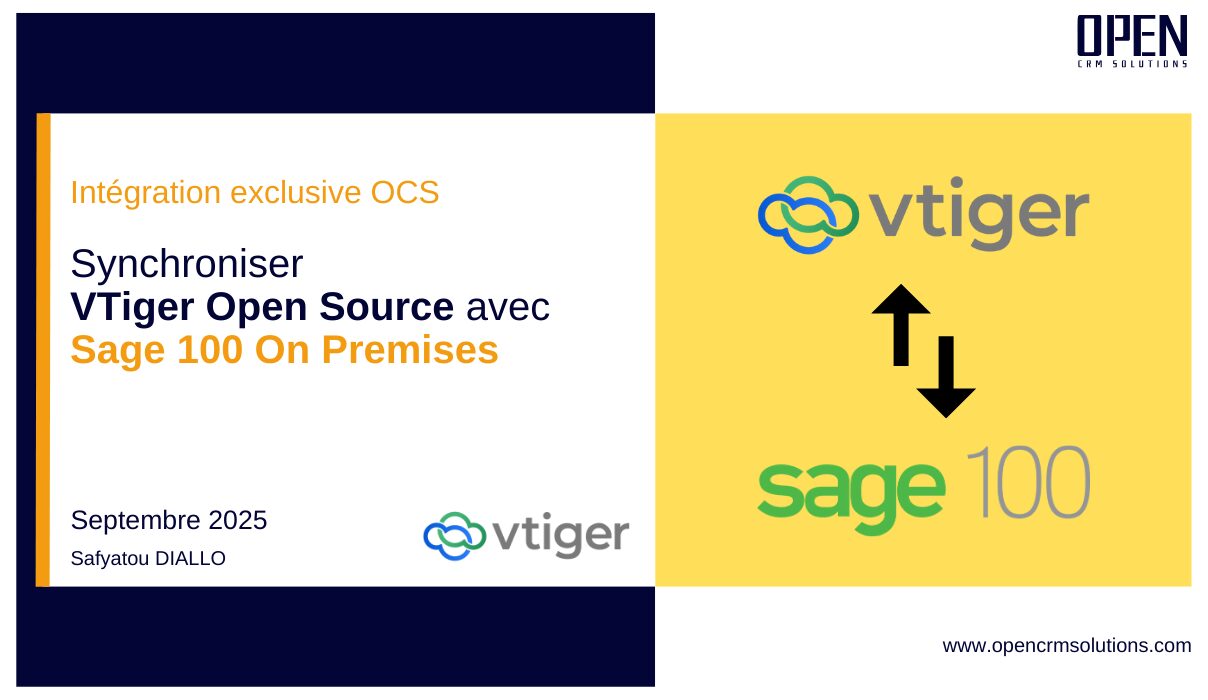
Le CRM Vtiger et la prospection
Vtiger est un CRM qui a une logique particulière qu’il est indispensable de s’approprier lorsque l’on veut déclencher les bénéfices apportés par la numérisation du processus commercial dans un CRM.
La prospection à deux niveaux
Dans Vtiger, vous disposez d’un menu LEADS (prospects), il réunit les personnes qui arrivent dans le CRM par import, email entrant, soumission d’un formulaire web, appel entrant ou interaction directe et pour lesquels vous devez procéder à une découverte de base.
Le lead, un enregistrement unique
Le lead a une particularité qui parfois est considérée comme un désagrément : il ne permet pas d’associer plusieurs personnes physiques ou personnes morales à une opportunité d’affaires.
Le lead, c’est dans le même enregistrement :
- un contact physique,
- une raison sociale,
- une seule adresse postale,
- un téléphone,
- un email.
Le lead est un enregistrement qui est simple et concis, car il n’a qu’une seule raison d’être : découvrir ou non l’opportunité d’affaires possible pour votre entreprise.
La conversion d’un prospect
Ainsi, un lead signifie que vous devez identifier si une vente est possible.
Si c’est le cas, le lead est converti et vous passez alors d’un seul enregistrement à trois : le(s) contact(s) physique(s) dans la base CONTACTS, la personne morale qui sera facturée dans la base COMPTES et l’opportunité commerciale devient une AFFAIRE.

L’importance de ne pas mixer LEADS et CONTACTS
Souvent, les utilisateurs Vtiger se précipitent pour importer les personnes physiques dont ils disposent dans la base CONTACTS, cette approche est erronée.
Un LEAD ne peut pas être à la fois prospect et client, donc vous pouvez ne pas avoir la même personne dans la base de données LEADS et dans la base de données CONTACTS.
Comment organiser votre import ou nettoyage de contacts dans VTIGER ?
- Dans un tableur, séparez les contacts clients et anciens clients des prospects.
- Les contacts clients et anciens clients appartiennent à la base de données CONTACTS de Vtiger et sont respectivement associés à un COMPTE — la personne morale rattachée à ces contacts clients.
- Les prospects sont à scinder à nouveau en deux groupes :
- Les prospects pour lesquels une découverte d’affaires reste à faire sont des LEADS. Cela signifie que vous devez enclencher une prise de contact pour savoir si l’attente/le besoin de ce prospect est susceptible de faire l’objet d’une vente.
Vous ne convertirez, depuis VTIGER, ces LEADS en CONTACTS + COMPTES + AFFAIRES seulement après fait cette découverte de base. - Les prospects pour lesquels vous êtes certains qu’une vente est possible, car leur attente/besoin correspond aux produits et services que vous vendez, ces prospects sont des CONTACTS à associer avec une AFFAIRE et à rattacher à un COMPTE.
- Les prospects pour lesquels une découverte d’affaires reste à faire sont des LEADS. Cela signifie que vous devez enclencher une prise de contact pour savoir si l’attente/le besoin de ce prospect est susceptible de faire l’objet d’une vente.
En respectant cette logique, votre CRM est en accord avec la règle d’or de la prospection Vtiger et vous pouvez bénéficier de tableaux de bord et de rapports correctement calibrés.
De plus, cette logique a le mérite d’être claire dans la gestion des contacts :
- les LEADS sont des potentielles opportunités d’affaires,
- les CONTACTS sont les personnes physiques pour lesquelles des opportunités ont été constatées, répertoriées en tant qu’AFFAIRES et associées à une personne morale dans la base COMPTES qui sera l’entité à facturer.
À retenir :
- Une personne ne peut être à la fois un LEAD et un CONTACT
- Les CONTACTS, AFFAIRES et COMPTES sont créés lors de la conversion d’un LEAD
- Un COMPTE est une personne morale qui sera facturée si la vente est conclue
- Un CONTACT est une personne physique rattachée à un COMPTE et à une AFFAIRE
- Une AFFAIRE est une opportunité commerciale qui peut réunir plusieurs contacts du même COMPTE
- Il est important de respecter la logique du CRM pour tirer parti des outils Vtiger et avoir une clarté sur la situation commerciale de l’entreprise
Vous avez un projet CRM ? Réservez un entretien visio avec Safyatou Diallo dès maintenant.


